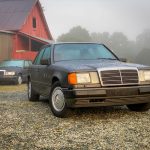Last week we introduced you to the American Austin, the titchy small car that was supposed to conquer the US – but which (unsurprisingly) failed to make much of a dent. When that project went belly up, it was then taken over by the man who had been brought in to turn the company around: Roy Evans. Although he had failed to revive the company’s fortunes in 1932, there were enough people who had faith in him to salvage something from the wreckage, and in June 1936 American Austin was reborn as the American Bantam Car Company.
With the economy in tatters it was assumed that Evans had just had some bad luck in trying to turn things round for American Austin. The town of Butler where the company was based, desperately needed a centre of employment and the car factory was the perfect solution, which is how Evans came to buy the land, buildings and manufacturing plant for just $5000 – when it was valued at $10 million. A lot of people had a lot of faith in the 34-year old salesman.

Evans set about raising $2 million in funding, and he put an experienced and talented management team in place. but almost immediately things started to go wrong. The funding was to be secured through the sale of shares, but unfortunately the brokers assigned to sell the shares pocketed what cash they raised, then disappeared with it. Evans instead had to take out a $250,000 loan to get his relaunched compact car into production.
Alexis de Sakhnoffsky, the man who had turned the British Austin into an American one, was drafted back in to revisit the car’s design. He charged just $300 for his work, which involved redesigning the front and rear ends as well as the dashboard. For good measure some spats were added to the rear wheelarches for a final flourish of elegance. By the time American Bantam had tooled up for the refreshed car, the bill was a mere $7000; an incredibly low sum, even if underneath, the car was pretty long in the tooth.

When American Austin had taken out its licence to build the Austin Seven, the deal included a fee of $10 for each engine made. Evans recruited Harold Crist to redesign Austin’s 747cc four-pot enough to ensure that this cash no longer had to be paid. The relaunch involved lots of other fine-tuning, to ensure reliability along with ease of use; the gearbox and rear axle were re-engineered while the chassis was also beefed up. By autumn 1937 the car was ready to go on sale
American Bantam’s new car was unveiled in September and within days 3300 dealers had signed up to sell the cars, which were sold using the slogans ‘Style, Stamina, Safety, in America’s only economy car’, and ‘Nearly a ton less to start, stop, park, operate and pay for’. Crucially, the American Bantam was eminently affordable at $439-$499 depending on model, with 60mpg within reach, helping to reduce running costs.




Those who bought an American Bantam invariably loved their cars, but most Americans couldn’t be convinced that such a small car was safe or comfortable, and they stayed well away. A camping trailer was developed in a bid to diversify, along with a quarter-ton truck and even a four-wheel drive go-anywhere vehicle. American Bantam also created one-off commissions for clients, but overall sales of 2000 or so vehicles for 1938 were far lower than the company needed to survive. Things were even worse in 1939 when 1225 cars were sold, and by 1940 they had dropped to 800 units.
In the first half of 1940 American Bantam explored the manufacture of agricultural machinery, but that proved to be a cul de sac, and by June 1940 the company was in dire straits. It struggled on and in the first few months of 1941 another 138 cars were sold, although they had all been made the previous year. But salvation was at hand, because from mid-1940 American Bantam had been working with the US Army on developing a go-anywhere vehicle to transport troops across difficult terrain. That four-wheel drive vehicle developed previously had been noticed by the US military and it provided the perfect basis for what the Army needed.

In September 1940 American Bantam started to undertake trials of its new four-wheel drive car, but it had also started to develop utility trailers, aerial torpedo engines and hydraulic equipment for aircraft, so its factory in Butler, Pennsylvania was busier than ever. Of course that four-wheel drive vehicle was the Jeep, and while it was American Bantam that produced the first fully functional prototypes, it would be Willys and Ford that would be given the contracts to make them, because they had the production capacity; American Bantam was left on the sidelines, producing the trailers and other equipment, along with just a handful of Jeeps.
Had it not been for World War 2 American Bantam would have shut down in 1940 or maybe 1941. Instead it got a stay of execution right through the war; during the first half of the Forties it was finally truly profitable. But with hostilities over in 1945 the company had to stand on its own two feet once again. By this point Roy Evans had moved on as he had no interest in the military work. His place had been taken by Wayne Aspen who knew that reviving car production was never going to work, so instead the company moved into utility trailers. For a decade American Bantam managed to eke out an existence, but by 1956 it was all over, the factory was sold and the company became a footnote in automotive history.
Check out the Hagerty Media homepage so you don’t miss a single story, or better still, bookmark it.









